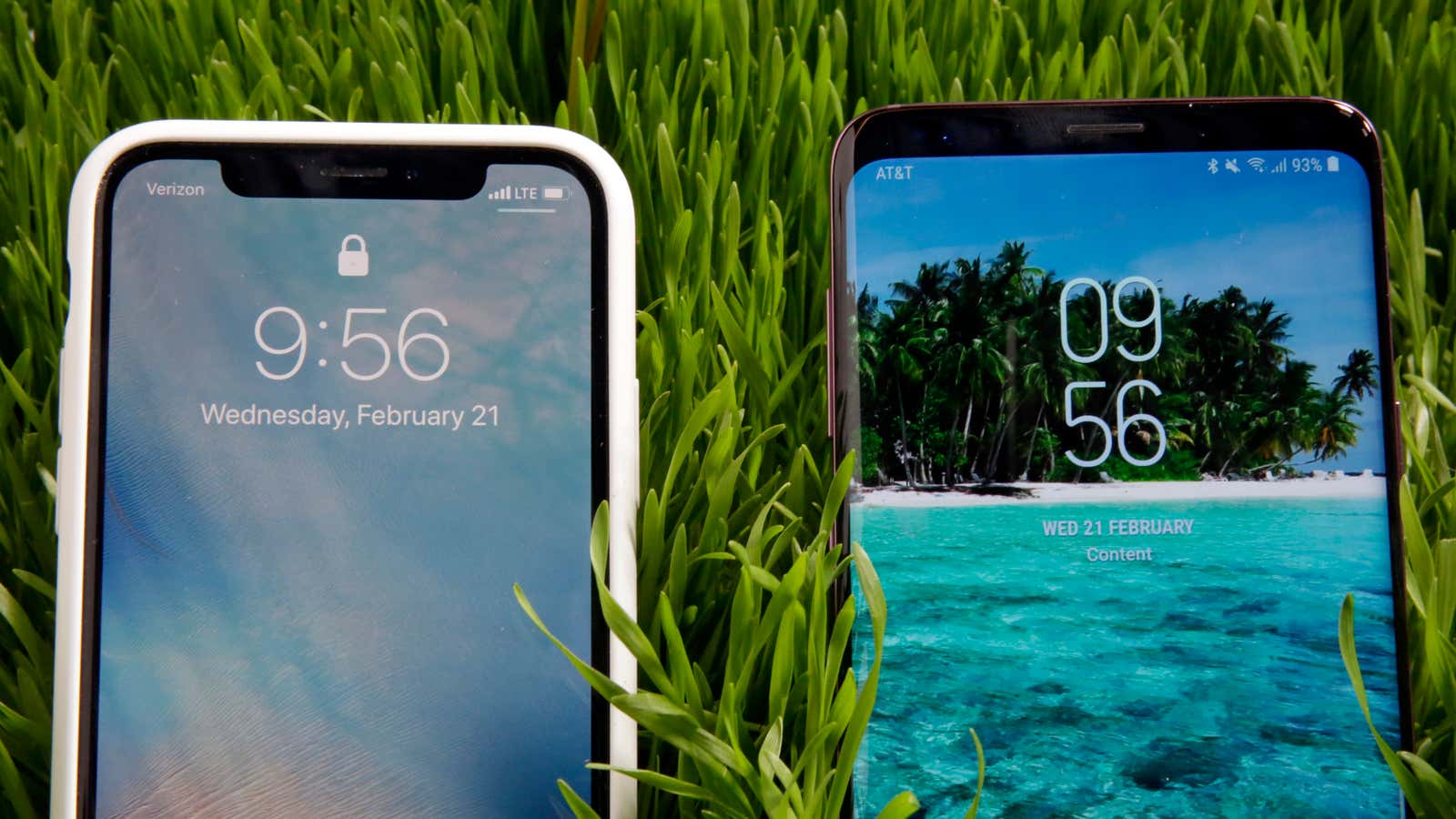iPhone X: “Say hello to the future.”
The Galaxy S9: “The camera. Reinvented.”
This is how the two biggest names in smartphones sum up their top-of-the-line products. Apple says its phone is “so immersive the device itself disappears into the experience.” Samsung says it’s phone has a “revolutionary camera that adapts like the human eye.”
But in reality, when it comes to their most important selling points—their cameras, battery life, storage, and speed—there really isn’t much difference between the iPhone X and Galaxy S9.
Electronics companies typically do not publicize the components they use to assemble their products. But expert tear-downs, carried out by organizations like iFixit and TechInsights, provide windows into the source materials used by Apple and Samsung in their flagship phones. What they show is very little difference between the two devices.
Obviously not every component in these two phones is the same. There are tons of small differences, especially on more minor parts. And the two companies sometimes differ in how they use these technologies. But the tear-downs reveal that major parts of these phones are the same or very similar.
That means that when you decide between a top-end Samsung or Apple product, all you’re buying is an ethos, rather than a device that’s categorically better than another. You’re basically choosing between Apple’s unified design language, operating system, and closed-off ecosystem, or the more expandable, customizable world of Android phones. That said, whatever you choose, you’ll get a very good phone, with very similar capabilities to its competitor.
TechInsights also revealed that the iPhone X costs roughly $390 to build, about $10 more than the site’s production cost-estimate for the larger Samsung Galaxy S9+. (No one appears to have down a production-cost breakdown of the regular S9. For the purposes of the comparison below, we’re using the regular Galaxy S9, as it’s a little closer to the iPhone X in size.)
Display size and pixel density
iPhone X: 5.8-inch Samsung Super AMOLED touchscreen, 458 pixels per inch, 16 million colors,
Galaxy S9: 6.2-inch Samsung Super AMOLED touchscreen, 570 pixels per inch, 16 million colors
Apple’s main display partner is Samsung, which recently reported weaker-than-expected demand from other phone manufacturers for its screens, perhaps because so few people are buying iPhone Xs. Samsung’s own display is sharper than the one it supplies for Apple’s iPhone X, however. The Galaxy S9’s has a pixel density is over 100 pixels per inch higher than the iPhone x’s.
Processor speed
iPhone X: Apple A11 Bionic 2.39 GHz
Galaxy S9: Samsung Exynos 9810 2.7 GHz (in Europe) or Qualcomm Snapdragon 845 2.8 GHz (in the Americas/China)
Samsung uses its own chips for the phones it sells in Europe, the Middle East, and Africa, and the latest Qualcomm chips for the phones it makes for sale everywhere else. Apple uses a chip produced by the Taiwan Semiconductor Manufacturing Company (TSMC). Both the Samsung and TSMC chips are built on roughly the same architecture, developed by British chip-design firm, Arm. The two companies may utilize that architecture in slightly different ways for the needs of their devices, but they’re starting from roughly the same point.
Camera quality
iPhone X: Dual 12-megapixel cameras
Galaxy S9: Single 12-megapixel camera
Samsung uses Sony cameras for the phones it sells in the US and China, and its own sensors in those sold to the rest of the world. Apple is tight-lipped about who supplies its parts, but when it comes to the X’s cameras, signs point to Sony, as well.
This isn’t a fair, direct comparison, since the iPhone X has two cameras that can provide a better depth of focus than the Galaxy S9—and Samsung’s larger flagship phone, the Galaxy S9+, has two cameras like the X. A prominent image quality-testing site, DxOMark, gave the S9+ and the X the third- and fifth-highest reviews it’s ever given to a smartphones. Both were bested by Huawei’s P20, which were only released about two weeks ago, and the iPhone X was also beat by Google’s Pixel 2. (DxOMark did not separately review the Galaxy S9.)
Battery life
iPhone X: 2716 milliamp-hours
Galaxy S9: 3000 milliamp-hours
Samsung’s Galaxy S9 uses a single battery pack it built itself. Apple’s iPhone X uses two smaller battery packs made by Sunwoda, a Chinese electronics firm.
Combined, the iPhone X’s two batteries, which are stuck together inside the device, are a bit smaller than the Galaxy S9’s one power source, so the latter should eke out a few extra moments of life—even though it will have to power the S9’s bigger screen.
Apple claims the X will get up to 21 hours of talk time, whereas Samsung says the S9 will get up to 31 hours.
Other parts that differ between the iPhone X and Galaxy S9
The two phones both have at least 64 GB of storage (with a 256 GB upgrade available for the iPhone, and 128 GB for the S9), are water-resistant, have Qi wireless charging, use laser projectors on the front of the phone to recognize your face, and have built-in contactless payments technology.
There are differences: The S9 has a headphone jack, a fingerprint scanner, and a home button. The iPhone X does not. But, it does have far superior sensors on its face for augmented reality and security features.
Choosing between the iPhone X and Galaxy S9
Ultimately, if you’re thinking of splashing out up to $1,000 on a smartphone, you don’t need to worry too much about deciding between the iPhone X and Galaxy S9. You can’t really go wrong with either choice. In fact, for the most part, top smartphones from most quality manufacturers are going to provide relatively similar experiences. Whatever side you take in the seemingly never-ending Android versus Apple debate, you’re going to get a really powerful, useful phone. At least, until the next one comes out.
